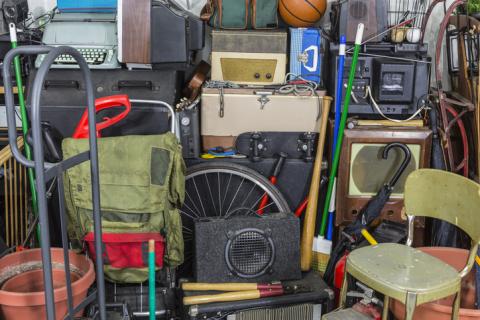When a Loved One Hoards
Collecting, or hoarding?
Over the years, our homes can become stuffed with stuff. Maybe we have a stack of magazines that we’re sure we’ll read … someday. We cram a spare closet with old clothes that “might come back into style someday.” The infamous “piles” form here and there in the home as we consider what to do with items that have emotional and symbolic value to us. Many people collect things—fridge magnets, comic books, ceramic figurines, books, antiques and the like.
But hoarding goes well beyond that. The home isn’t just messy or cluttered—it’s dangerous and fundamentally unlivable. Here are signs that a person may have a hoarding disorder:
- Bringing more and more items home, while discarding nothing
- Compulsive shopping, sometimes purchasing several of the same item
- Saving junk mail, packaging materials and obsolete, useless items
- Items unopened in their original packaging
- Unsafe or unsanitary conditions (e.g., fire hazards, insects, rodents, spoiled food)
- Clutter that prevents the person from using the kitchen, bedroom or bathroom or accessing items they actually need
- Isolation; not wanting to let anyone in the home
- Conflict with family and friends about the condition of the home
What causes hoarding disorder?
This excessive accumulation of possessions is actually a mental disorder. Formerly classified as a type of obsessive-compulsive disorder, hoarding was recently reclassified as a distinct form of mental illness. It may run in families, though experts say this could be a matter of learned behavior rather than genes. It also may worsen as a person grows older.
The causes of hoarding have always been something of a mystery. But recent research funded by the National Institute of Mental Health used brain imaging to show that people with hoarding disorder often have abnormal activity in parts of the brain that govern decision-making. Study author David Tolin, Ph.D., of Hartford Hospital in Connecticut, explained that this overactivated brain activity causes a “lack of self-insight, indecisiveness, sense that the wrong decision is being made, inflated estimates of the desirability of objects, and exaggerated perception of risk that are often experienced with the disorder.”
Can hoarding disorder be treated?
Treatment for this condition can be challenging. People who are struggling with hoarding seldom can get the impulse under control without help. Yet intervention is difficult, especially when the person doesn’t see the squalor as a problem. Family and friends often want to help, but their tidying is likely to be perceived as interference.
Tolin told the NIH News in Health that at present, medications are ineffective. “Right now, cognitive behavioral therapy is the only evidence-based treatment that we have for hoarding,” he says. He suggests that a support group also could help.
What can family do?
Social service agencies may step in; many communities today have interagency “hoarding task forces.” Mental health professionals and support groups help people understand the problem and underlying causes. “Organization coaches” and specialized cleaning services can assist in dealing with extremely cluttered home conditions. Aging life care professionals (geriatric care managers) can coordinate these services and develop a plan for dealing with unsafe living conditions.
If your loved one resists help, seek an evaluation from a trained therapist or other mental health professional. Your local senior services agency may also be able to offer suggestions. You can learn more from the International OCD Foundation’s hoarding resources center hoarding.iocdf.org.
